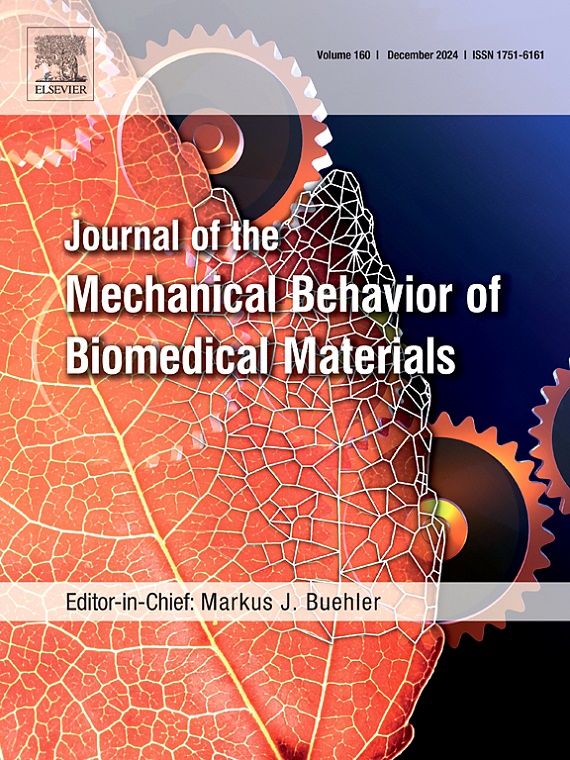An in vitro study of the effects of pathophysiologically relevant levels of oxidative damage on cortical bone tissue quality
IF 3.3
2区 医学
Q2 ENGINEERING, BIOMEDICAL
Journal of the Mechanical Behavior of Biomedical Materials
Pub Date : 2025-07-04
DOI:10.1016/j.jmbbm.2025.107108
引用次数: 0
Abstract
This study examined the impact of in vitro oxidative damage on cortical bone tissue quality assessed using mechanical testing, biochemical assays, and thermo-analytical methods. The primary hypothesis of this study was that oxidative damage, caused in vivo by oxidative stress—a key factor in aging and various inflammatory diseases—deteriorates bone tissue quality by damaging bone collagen, the main component of the bone's organic phase. To test this hypothesis in vitro, bovine cortical bone specimens were exposed to neutral hypochlorous acid solution (a potent reactive oxygen species) to induce oxidative damage, which was measured in terms of carbonylation. Carbonylation is a stable biomarker of protein oxidation. Mechanical testing revealed degradation of cortical bone mechanical properties due to oxidation. There was a marked degradation of mechanical properties, specifically pre-yield and post-yield properties such as tensile (30–40 %) and compressive (19–23 %) yield strength, as well as tensile (25–45 %) and compressive (11–16 %) ultimate strength. Exposure to neutral hypochlorous acid solutions increased the carbonyl content (normalized to collagen content), confirming protein oxidative damage. In addition, the observed carbonyl levels in the oxidized groups were similar to those measured in human cortical bone specimens. Thermo-analytical tests including differential scanning calorimetry (DSC) and hydrothermal isothermal tension (HIT) tests, providing measures of collagen nativity and connectivity, revealed negative correlations with carbonyl content (r = −0.46, p = 0.0038). The hypothesis that physiological levels of oxidative damage generated in vitro degrade cortical bone mechanical properties by damaging the bone collagen has been confirmed. This suggests that oxidative damage of bone collagen is important towards understanding the degradation of bone quality in aging and various diseases.
氧化损伤病理生理相关水平对皮质骨组织质量影响的体外研究
本研究考察了体外氧化损伤对皮质骨组织质量的影响,采用力学测试、生化分析和热分析方法进行评估。本研究的主要假设是,氧化应激在体内引起的氧化损伤——衰老和各种炎症疾病的关键因素——通过破坏骨胶原(骨有机相的主要成分)而使骨组织质量恶化。为了在体外验证这一假设,将牛皮质骨标本暴露于中性次氯酸溶液(一种有效的活性氧)中以诱导氧化损伤,并根据羰基化来测量氧化损伤。羰基化是一种稳定的蛋白质氧化生物标志物。力学试验显示氧化导致皮质骨力学性能退化。力学性能有明显的退化,特别是屈服前和屈服后的性能,如抗拉(30 - 40%)和抗压(19 - 23%)屈服强度,以及抗拉(25 - 45%)和抗压(11 - 16%)极限强度。暴露于中性次氯酸溶液中增加了羰基含量(与胶原蛋白含量标准化),证实了蛋白质的氧化损伤。此外,在氧化组中观察到的羰基水平与在人类皮质骨标本中测量到的相似。热分析测试,包括差示扫描量热法(DSC)和热液等温张力(HIT)测试,提供了胶原原生性和连通性的测量,显示羰基含量与羰基含量呈负相关(r = - 0.46, p = 0.0038)。体外产生的生理水平的氧化损伤通过破坏骨胶原蛋白来降低骨皮质力学性能的假设已经得到证实。这表明骨胶原蛋白的氧化损伤对于理解衰老和各种疾病中骨质量的退化是重要的。
本文章由计算机程序翻译,如有差异,请以英文原文为准。
求助全文
约1分钟内获得全文
求助全文
来源期刊

Journal of the Mechanical Behavior of Biomedical Materials
工程技术-材料科学:生物材料
CiteScore
7.20
自引率
7.70%
发文量
505
审稿时长
46 days
期刊介绍:
The Journal of the Mechanical Behavior of Biomedical Materials is concerned with the mechanical deformation, damage and failure under applied forces, of biological material (at the tissue, cellular and molecular levels) and of biomaterials, i.e. those materials which are designed to mimic or replace biological materials.
The primary focus of the journal is the synthesis of materials science, biology, and medical and dental science. Reports of fundamental scientific investigations are welcome, as are articles concerned with the practical application of materials in medical devices. Both experimental and theoretical work is of interest; theoretical papers will normally include comparison of predictions with experimental data, though we recognize that this may not always be appropriate. The journal also publishes technical notes concerned with emerging experimental or theoretical techniques, letters to the editor and, by invitation, review articles and papers describing existing techniques for the benefit of an interdisciplinary readership.
 求助内容:
求助内容: 应助结果提醒方式:
应助结果提醒方式:


